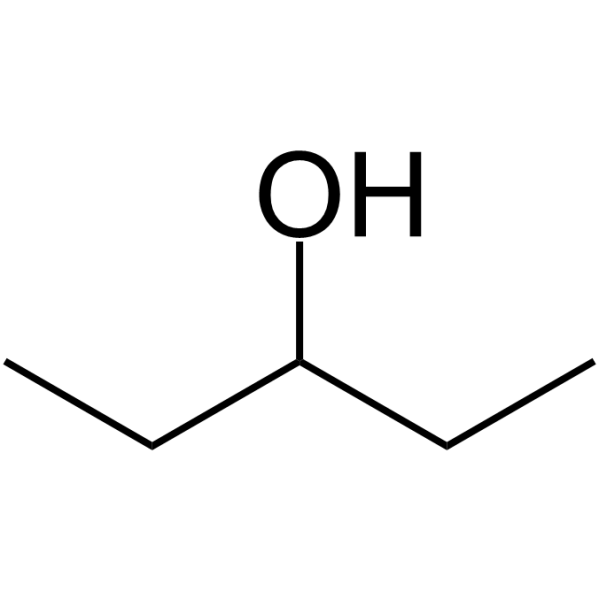Physicochemical Properties
| Molecular Formula | C5H12O |
| Molecular Weight | 88.15 |
| Exact Mass | 88.088 |
| CAS # | 584-02-1 |
| Related CAS # | 3-Pentanol-d5;144032-75-7 |
| PubChem CID | 11428 |
| Appearance | Colorless to light yellow liquid |
| Density | 0.8±0.1 g/cm3 |
| Boiling Point | 115.3±0.0 °C at 760 mmHg |
| Melting Point | -75 °C |
| Flash Point | 40.6±0.0 °C |
| Vapour Pressure | 9.7±0.4 mmHg at 25°C |
| Index of Refraction | 1.405 |
| LogP | 1.22 |
| Hydrogen Bond Donor Count | 1 |
| Hydrogen Bond Acceptor Count | 1 |
| Rotatable Bond Count | 2 |
| Heavy Atom Count | 6 |
| Complexity | 23.1 |
| Defined Atom Stereocenter Count | 0 |
| SMILES | CCC(CC)O |
| InChi Key | AQIXEPGDORPWBJ-UHFFFAOYSA-N |
| InChi Code | InChI=1S/C5H12O/c1-3-5(6)4-2/h5-6H,3-4H2,1-2H3 |
| Chemical Name | pentan-3-ol |
| HS Tariff Code | 2934.99.9001 |
| Storage |
Powder-20°C 3 years 4°C 2 years In solvent -80°C 6 months -20°C 1 month |
| Shipping Condition | Room temperature (This product is stable at ambient temperature for a few days during ordinary shipping and time spent in Customs) |
Biological Activity
| References |
[1]. Gaseous 3-pentanol primes plant immunity against a bacterial speck pathogen, Pseudomonas syringae pv. tomato via salicylic acid and jasmonic acid-dependent signaling pathways in Arabidopsis. Front Plant Sci. 2015 Oct 6;6:821. |
| Additional Infomation |
Sec-amyl alcohol appears as a clear colorless liquid with a strong odor. Moderately toxic by ingestion and vapors may irritate skin and eyes. Vapors are heavier than air. Pentan-3-ol is a secondary alcohol that is pentane substituted by a hydroxy group at position 3. It is produced by plants and is a component of emitted insect sex pheromones. It has a role as a pheromone, a biomarker, a plant metabolite and a fuel additive. It is a secondary alcohol and a pentanol. 3-Pentanol has been reported in Zingiber mioga, Opuntia ficus-indica, and other organisms with data available. |
Solubility Data
| Solubility (In Vitro) | DMSO : 100 mg/mL (1134.43 mM) |
| Solubility (In Vivo) |
Solubility in Formulation 1: ≥ 2.5 mg/mL (28.36 mM) (saturation unknown) in 10% DMSO + 40% PEG300 + 5% Tween80 + 45% Saline (add these co-solvents sequentially from left to right, and one by one), clear solution. For example, if 1 mL of working solution is to be prepared, you can add 100 μL of 25.0 mg/mL clear DMSO stock solution to 400 μL PEG300 and mix evenly; then add 50 μL Tween-80 to the above solution and mix evenly; then add 450 μL normal saline to adjust the volume to 1 mL. Preparation of saline: Dissolve 0.9 g of sodium chloride in 100 mL ddH₂ O to obtain a clear solution. Solubility in Formulation 2: ≥ 2.5 mg/mL (28.36 mM) (saturation unknown) in 10% DMSO + 90% (20% SBE-β-CD in Saline) (add these co-solvents sequentially from left to right, and one by one), clear solution. For example, if 1 mL of working solution is to be prepared, you can add 100 μL of 25.0 mg/mL clear DMSO stock solution to 900 μL of 20% SBE-β-CD physiological saline solution and mix evenly. Preparation of 20% SBE-β-CD in Saline (4°C,1 week): Dissolve 2 g SBE-β-CD in 10 mL saline to obtain a clear solution. Solubility in Formulation 3: ≥ 2.5 mg/mL (28.36 mM) (saturation unknown) in 10% DMSO + 90% Corn Oil (add these co-solvents sequentially from left to right, and one by one), clear solution. For example, if 1 mL of working solution is to be prepared, you can add 100 μL of 25.0 mg/mL clear DMSO stock solution to 900 μL of corn oil and mix evenly. (Please use freshly prepared in vivo formulations for optimal results.) |
| Preparing Stock Solutions | 1 mg | 5 mg | 10 mg | |
| 1 mM | 11.3443 mL | 56.7215 mL | 113.4430 mL | |
| 5 mM | 2.2689 mL | 11.3443 mL | 22.6886 mL | |
| 10 mM | 1.1344 mL | 5.6721 mL | 11.3443 mL |
